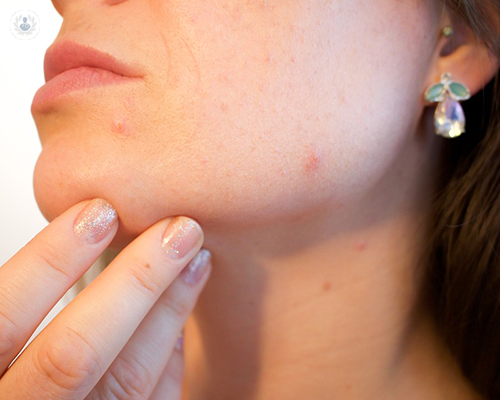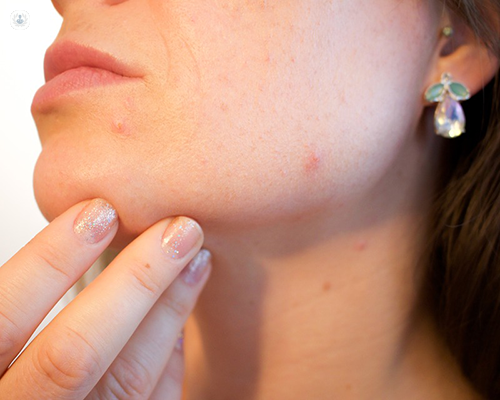
All you need to know about acne treatments
Young people who suffer from acne usually see an improvement after puberty. However, what happens when acne leaves skin lesions and scars that affect the skin texture of the face?

Acne can be treated but acne scars remain. Acne mainly affects areas of the skin with greater density of sebaceous glands. These include the face, chest and upper back. The presence of pustules and nodules gives rise in some cases to scars that can leave terrible marks on the skin.
What are acne scars?
Acne scars are the result of infections and inflammations of the skin that in most cases have not been cured properly. Acne scars can last a lifetime.
How to prevent acne scars
At present, acne scars can be treated thanks to the innumerable advances in cosmetic medicine. The annoying acne scars that some men and women have can be eliminated nowadays with various techniques. It is important to emphasise that to prevent the formation of these unsightly scars it is essential that the person with acne does not pop and pick at pimples because that spreads the infection and causes marks of greater intensity. Prevention plays a relevant role in avoiding the risk of scarring.
Types of Acne Scars
In general terms, there are two types of scars: raised and depressed. Depressed acne scars are the most common and show on the skin as “holes”.
Raised acne scars
These types of scars are not as common as depressed acne scars. They are more obvious, present a colouration of the skin and are more common in people who have darker skins, although it is true that this type of epidermis is less prone to suffer from acne. It can be said therefore, that the darker the skin the more tendency there is to suffer this problem.
Depressed acne scars
These are scars that show as broad depressions in the skin, which are commonly known as rolling scars. There is another type that looks similar to chickenpox scars and are known as boxcar scars, and a third type that are called ice pick scars, which are deep and narrow. In most of these cases, patients have had their pimples infected with pus. Generally, these scars are caused by the patient squeezing and picking at their pimples.
Ways to Remove Acne Scars
While proper acne treatment can minimize scarring, there are now a number of procedures and techniques that effectively eliminate these skin lesions. These include surgery-free procedures such as dermabrasion, peeling, microdermabrasion and treatment with CO2 lasers.
Peeling
Peeling consists of the application of different substances to exfoliate the more extensive layers of the skin. It is an English word that comes from the verb "peel ", i.e. peeling the skin in a figurative way. Peels not only eliminate acne scars - depending on their intensity - but are used with excellent results in cosmetic medicine to eliminate wrinkles and age spots. The amount of time of the peeling procedure takes depends on its penetrative power and extent of the area treated. It is necessary to take into account that the deeper it needs to go, the greater the risk. Usually anaesthesia is required, although in some cases for a deeper type of peeling, phenol sedation is often used. This procedure produces an itching sensation at the beginning, followed by redness, cicatrisation and alterations in the sensitivity of the skin. It is important to emphasise that if it is a deep type of peeling, it must be performed in the operating room with hospitalisation of 1 to 2 days. Recovery time for the skin depends largely on the peel used – one day for the simplest procedure and up to six months for deeper peeling. In the case that phenol has been used, there will be a permanent bleaching of the skin and an inability to re-tan.
Dermabrasion
Dermabrasion is a treatment that is based on removing the epidermis and the superficial dermis. Traditionally, wet or dry sandpaper was used, although it has now been replaced by rotating instruments. The materials used for dermabrasion can range from gypsum to aluminium oxide crystals, although the most widely used today are diamond fraise attached to a motor of 12,000 to 15,000 revolutions per minute. It is possible that after the use of this technique there is a slight hypo-pigmentation in the treated area.
Chemical exfoliation
Chemical exfoliation is often done to treat skin with scars caused by acne. This type of exfoliation involves removing the top layer of the skin through the use of a chemical. It is one of the best techniques to remove superficial scars because the skin regenerates and its appearance is considerably improved.
Infrared Laser and CO2 Laser
The technique of surface or infrared laser and the CO2 laser developed and used by various dermatologists with considerable success and is now used in many other specialties of medicine and science. Both are considered phototherapeutic treatments. The basic differences between infrared laser and CO2 laser are the depth to which they work and the effects they produce on the skin. The infrared works at a more superficial level so it is used for milder acne scars.
The CO2 laser
The CO2 laser unlike the surface or infrared laser is more effective at eliminating deep and severe acne scars because it works at a greater depth, however, this method produces more intense burns on the skin making it a more painful procedure. This type of phototherapeutic treatment is of the ablative type, i.e. it vaporises the surface of the skin to stimulate the formation of new tissue. CO2 laser treatment requires anaesthesia and once it is finished, it is essential that the patient wears a protective dressing on the treated area. This bandage can be removed after 1 or 2 weeks depending on the sensitivity of the skin. It is vital that the skin - after the treatment - is not exposed to the sun's rays because these are new tissues that need to be completely regenerated to avoid the appearance of spots.
Nowadays, non-ablative lasers are being used - those that do not vaporise the surface of the skin - with good results. Studies from the University of North Western in the USA confirm this. For this type of laser, anaesthesia is not necessary and an average of 5 sessions at intervals of 3 weeks would suffice to eliminate the scars. Laser treatments are contraindicated for all people whose skin is brown or have some type of risk of hyper pigmentation.
Both the infrared laser treatment and the CO2 laser are effective solutions to eliminate scars and marks caused by acne, and these are used in many prestigious aesthetic clinics.
Facial lifting
Facial lifting is a common surgery technique in clinics and beauty centres. The lifting basically consists of stretching the skin. It is used in most cases when there is a severe laxity or flaccidity of the skin, obtaining impressive results in the elimination of imperfections, scars and other marks caused by acne. This technique of plastic surgery is performed in the operating room with a slight local anaesthesia and needs only a few hours of attendance at the hospital or clinic.
Collagen Injections
This technique is based on injecting a type of purified bovine collagen.. The goal is to replace the natural collagen that has been lost and as a result fill the scars produced by acne. In certain cases, bovine tissue may be replaced by other materials such as hyaluronic acid, polymethyl methacrylate microspheres, silicones or gora-tex, among others. For more superficial scars, autologous lipocollagen and laboratory-grown fibroblasts may be used.
Punch grafts
These are small skin grafts that aim to replace scarred skin. The skin is initially pierced to remove the scars and then replaced by a graft, usually with skin taken from the earlobe.
Autologous fat transfer
In this case, fat extracted from different parts of the body is used and injected it into the skin, filling and correcting the defects caused by acne. This fat is injected under the surface of the skin in order to raise the sunken scars. In some cases, the fat is reabsorbed, so it is necessary to repeat the operation.

